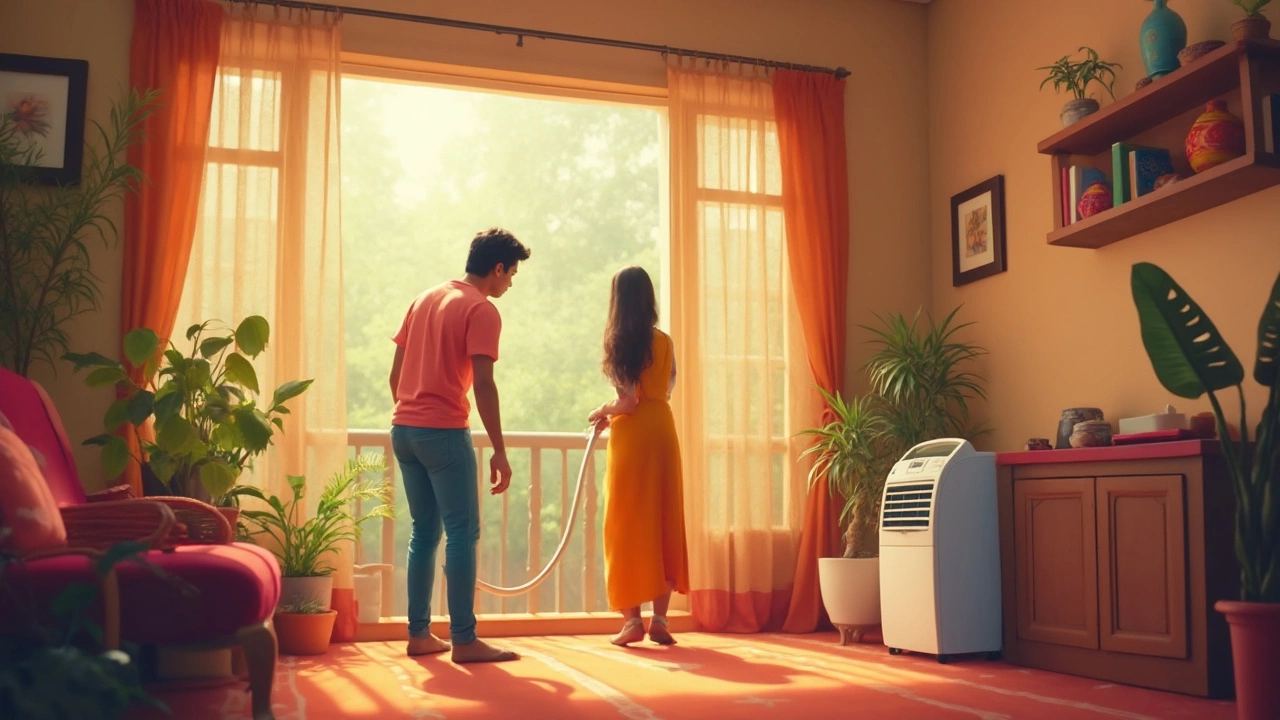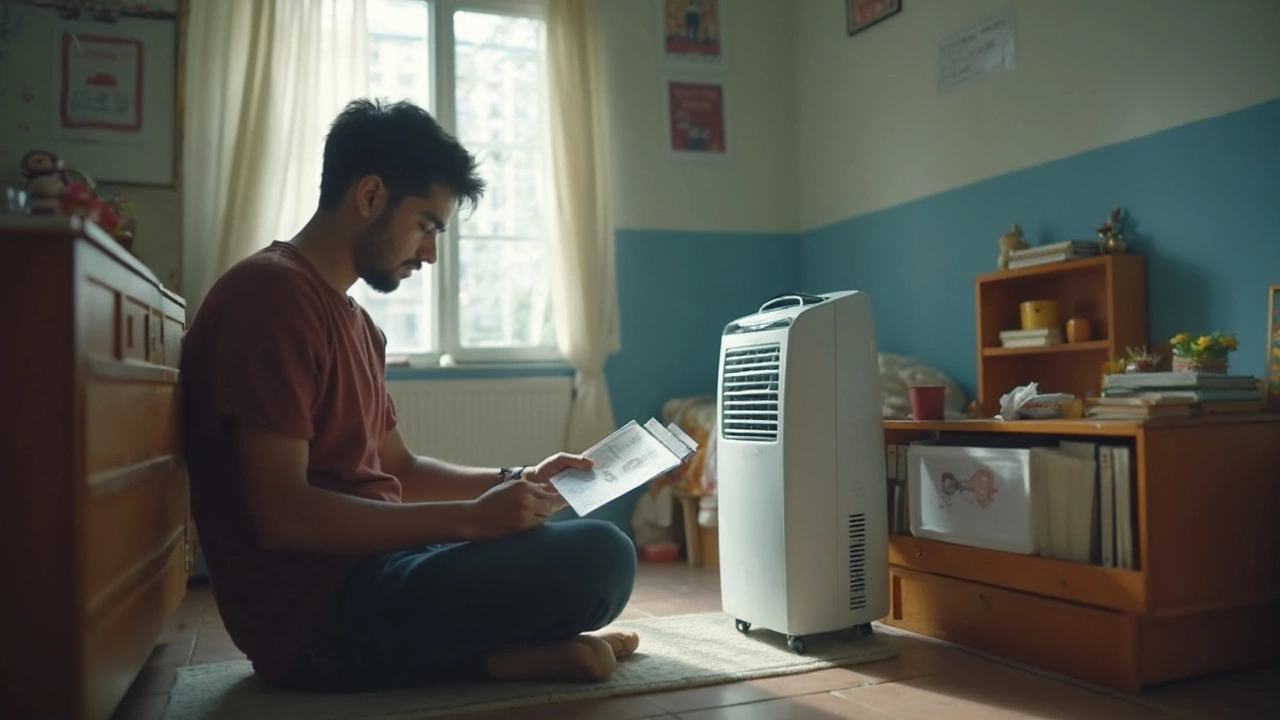
People often throw a portable air conditioner anywhere in a room and wonder why it barely cools things down. The spot you pick matters way more than you'd think, and it’s not just about where there's an open outlet. If you want cool air fast (without running up your electricity bill), you’ve got to get the setup right.
First things first: portable ACs need to push hot air outside. That means a window or sometimes a sliding door is non-negotiable. Dragging your portable AC across the room hoping it’ll work better by your favorite chair won’t help if the exhaust hose can’t actually reach outside. Poor placement leads to weak cooling, and worst case, you end up heating the room instead of chilling it. So, the trick is to position the unit close to a window, but not squeezed up against the glass—leave a bit of space for airflow around it.
You also want the cool air to actually hit where people hang out. If you hide your AC behind a couch or let curtains flap over its vents, it’s going to work way harder than it should just moving air around pointlessly. Think clear path: you want nothing blocking the flow from the front or the exhaust at the back. Sounds simple, but you’d be surprised how many folks block their AC with a pile of laundry and wonder why their apartment still feels tropical.
- Why Placement Matters More Than You Think
- Top Spots (and Bad Ideas) for Your Portable AC
- Smart Setups for Real-World Homes
- Extra Tips to Boost Cooling Power
Why Placement Matters More Than You Think
Here's a fact most people miss: the portable air conditioner isn't magic. It only works as well as you let it. Where you place the unit decides how fast it cools, how hard it runs, and how much you'll actually enjoy that cold air. Put it in the wrong spot and not only will your room stay stuffy, but you could also stress the unit, cause leaks, or even hike up your energy bill for nothing.
Ever notice how one corner of your room stays sweaty and the other feels like a refrigerator? That's often due to poor airflow. If your AC’s vents are blocked, facing a wall, or shoved behind a piece of furniture, you're basically trapping the cold air. And get this—most portable units suck in the air from the room, cool it, then dump the hot stuff outside. If you give it no breathing room, the cool air never gets a chance to spread, and the hot air can end up leaking right back in.
Your outlet situation matters too. A lot of folks use extension cords without realizing most portable ACs need a direct, grounded plug because they draw more power than you think. Using the wrong outlet or power strip can actually be a fire risk.
Humidity is another big deal. If you stick your AC right where the sun is blazing in, it has to work extra hard to keep up, and condensation can build up quicker. That can mean you’re emptying the water tray way more than you need to, or worse, you end up with a puddle on your floor.
So really, placement shapes everything—from comfort to safety to your wallet. If you want cold air you can actually feel, give your AC some open space by a window, keep it off carpets (so it stays level), and make sure the exhaust stays straight without bends. These small changes pack a bigger punch than you’d expect.
Top Spots (and Bad Ideas) for Your Portable AC
Picking the right spot for your portable air conditioner isn’t complicated, but getting it wrong can ruin your summer. The spot you choose decides how quickly a room cools down, how comfy you feel, and even how much you rack up on your energy bill. There’s more to it than just shoving it near the closest window.
Portable air conditioner units do best when they’re as close to a window as the exhaust hose allows, but not so close that airflow gets choked off. The hose should run as straight as possible—if you’ve got it twisted or bent, the AC has to work overtime and you lose out on cool air. The optimal distance from window to unit is generally around 10-20 inches so you get ventilation without blocking the unit’s air intake. Also, make sure the window kit seals up tight—small gaps can leak the hot air right back in.
If you’re wondering what NOT to do, here’s a quick rundown:
- Don’t put the AC in a corner or tucked behind furniture. Air needs space to circulate. If cold air blows into the back of a dresser or right into heavy drapes, you’ll barely feel it.
- Avoid placing the unit on carpet if you can. Some models overheat if their air intake is too close to the floor and carpet fibers can get sucked in, slowing everything down.
- Never position the exhaust hose through a wall into another room (tempting, but a bad call). You’re just dumping hot air into your house, not outside where it belongs.
- Steer clear of placing the unit near heat sources—like behind a TV or beside a sun-baked window. That just makes it work harder.
For rooms with weird layouts or few windows, consider using a sliding door or getting a longer hose (check your model’s limits though: many manufacturers warn against hoses longer than 6-8 feet). The longer the hose, the more you’ll lose efficiency, so only stretch your setup if there’s no other option.
Here’s a quick data snapshot to keep things in perspective:
| Placement Option | Cooling Efficiency | Energy Use | User Comfort |
|---|---|---|---|
| Near window, clear path | High | Low | Optimal |
| Corner, blocked vents | Low | High | Poor |
| Middle of room, long hose | Medium | Medium | Average |
| On carpet, low intake | Low | High | Poor |
The bottom line? Set your unit up near a window with nothing blocking it, keep the hose straight, and take a minute to see where airflow actually goes. If you’ve got a strange-shaped room or awkward furniture, sometimes a few tweaks—like moving a coffee table or raising the unit an inch off the ground—make a massive difference in how cool things get.

Smart Setups for Real-World Homes
Everyone’s home is a little different, but the basics for getting the most out of your portable air conditioner are pretty much the same. Start by choosing the room you spend the most time in, which is usually the living room or bedroom. You want your AC to be as close to a window as possible since that’s where the exhaust hose needs to go. A double-hung or sliding window works best—casement (crank) windows are trickier and might need a special kit.
Keep the hose straight and as short as possible. Kinks or long stretches make the AC work harder and can drop cooling power by up to 18%. Always check for a tight seal on the window adapter—leaks just pull the hot air right back in.
When picking the right spot, clear the zone around the AC by at least 20 inches. That way, it can pull in enough air and push cold air out without obstacles. If you have a big room (say over 400 square feet), don’t expect a smaller unit to perform miracles. For best results, match your unit’s BTU rating to your room size. Here’s a quick cheat sheet:
| Room Size (sq. ft.) | Recommended BTU |
|---|---|
| Up to 200 | 8,000 |
| 200-400 | 10,000–12,000 |
| 400+ | 14,000+ |
Don’t put the AC in a corner or behind furniture—this traps the chilled air, and you’ll just waste power. Try facing the unit so it blows air toward the main area where people are, instead of right into a wall. Some folks point a simple fan at the cooled air to help push it around the room, especially if it’s a long space or there are awkward corners. This tiny trick can make the chill spread way more evenly.
If you need to cool upstairs, remember: heat rises. A portable AC is going to have a much tougher job up there. If the space still feels stuffy, black-out curtains and closing doors to unused rooms keep the cool where you need it most. Sun blasting through windows? Put the unit in the shadiest spot you can, or at least pull the curtains closed during daylight hours. It makes a noticeable difference, and your AC won’t run non-stop just trying to catch up.
- Always drain the water tank—high humidity means you’ll be emptying it more often.
- If you rent or move a lot, look for a unit with easy-rolling wheels and a simple window kit.
- For year-round comfort, check if your portable AC has a "fan only" or dehumidifier mode for non-summer use.
Extra Tips to Boost Cooling Power
Alright, so once you have the right spot for your portable air conditioner, don’t stop there if you want it to work like a champ. Setting it up is only half the job—some extra tweaks can take your cooling up a notch.
- Seal up leaks: Any air sneaking in from gaps and cracks will add more heat for your AC to battle. Block the window gap around the hose with foam, and shut the door to keep the cool air from drifting away. It sounds basic, but a 2023 test from Consumer Reports showed rooms with window leaks took 30% longer to cool down.
- Keep it clean: Dust and dirt block vents and clog filters. Clean or swap the filter every few weeks during heavy use. A clogged filter can cut cooling power by up to 10%, according to most AC manuals.
- Control other heat: Turn off big electronics, lamps, and even the oven if you can. Anything that heats up your room just gives your AC more work. Even heavy curtains soaking up the afternoon sun will make a difference. Draw them closed during peak heat times.
- Check your hose: A short, straight exhaust hose will let hot air out much better than a long, snaky one. Every bend or long stretch makes the AC’s fan work harder and can mean up to 15% less power reaching your room, based on a test by Wirecutter in 2022.
- Use a fan: Set up a basic fan across the room to help move the cold air around. This helps the coolness actually get to every corner instead of pooling right in front of the AC. People report rooms cooling down about 20% faster with a fan helping out.
Curious how all these little moves add up? Check out the numbers in this table—it shows how each tip can affect both cooling speed and efficiency.
| Tip | Typical Cooling Time Reduction | Energy Savings |
|---|---|---|
| Seal leaks | Up to 30% faster | 10-15% less power used |
| Clean filter | 10% faster | 5-10% less power used |
| Short hose | 15% faster | Up to 10% less power used |
| Fan support | About 20% faster | N/A, but improves comfort |
| Block sun | 10-20% faster | 5-8% less power used |
These are easy changes that pretty much anyone can make. Put them together, and you’ll notice the room cools down quicker—and you might even knock a few bucks off your next electricity bill.